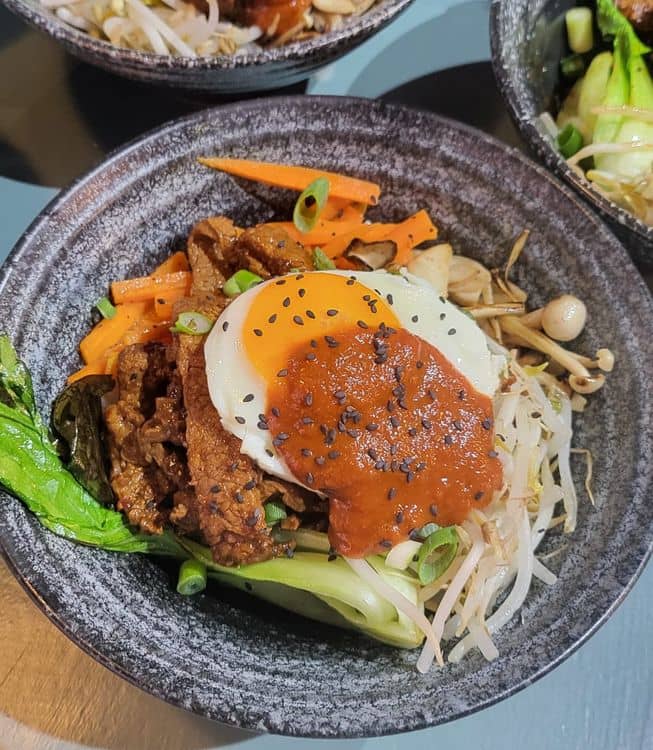A spicy beef, vegetable, and rice dish topped with an egg.

Stuck mid-recipe?
Chefadora AI has the answer - timers, swaps, step-by-step help.
Ingredients
Bowl
- Beef Bavette / Flank Steak (cut into thin strips)4cups
 Sushi Rice2cups
Sushi Rice2cups Gochujang Paste3/4cup
Gochujang Paste3/4cup Light Soy Sauce1/2cup
Light Soy Sauce1/2cup- Carrots (cut into matchsticks)2cups
- halves Pak Choi (cut lengthwise in half)8
- Mung Bean Sprouts (blanched)2cups
- Wild Mushrooms (sliced into chunks)2cups
 Sesame oil3tbsp
Sesame oil3tbsp Apple cider vinegar3tbsp
Apple cider vinegar3tbsp Sugar2tbsp
Sugar2tbsp Egg4piece
Egg4piece Black sesame seeds1tbsp
Black sesame seeds1tbsp Vegetable oil1/2cup
Vegetable oil1/2cup- Salt & pepper to taste
Gochujang Paste
- Dried Red Chillies (deseeded & soaked in hot water until soft)10piece
- Fresh Thai Red Chillies (deseeded)10piece
 Garlic5clove
Garlic5clove Miso Paste4tbsp
Miso Paste4tbsp Dark Soy Sauce1tbsp
Dark Soy Sauce1tbsp Palm Sugar (dissolved in hot water)2tbsp
Palm Sugar (dissolved in hot water)2tbsp Apple Cider Vinegar1tbsp
Apple Cider Vinegar1tbsp Paprika1tbsp
Paprika1tbsp
Nutrition (per serving)
Calories
846.0kcal (42.3%)
Protein
50.8g (100%)
Carbs
64.3g (23.36%)
Sugars
14.0g (28%)
Healthy Fat
20.5g
Unhealthy Fat
9.3g
% Daily Value based on a 2000 calorie diet
How to make Korean Beef Bibimbap
- Step 1
Place sushi rice in a medium pot and run water over it. Wash the rice by rubbing it between your hands. Rinse the rice until the water runs clear. Then add the same amount of water to the pot as rice. Bring the pot to a boil, then turn down the heat to the lowest setting. Cover the pot with a lid and cook for 15 minutes or until all the water has been absorbed. Turn off the heat and keep the lid on the pot for 10 minutes, then mix the rice and taste if it's cooked.
- Step 2
Pour the sugar, a little salt & apple cider vinegar over the rice & mix through with a fork. Transfer the rice to a bowl & set aside.
- Step 3
Make the gochujang paste: blend all ingredients together into a smooth paste. Add a little water to thin out if needed. Marinate the beef strips with half of the gochujang paste & the light soy sauce. Cover & set aside to marinate for about 20 min.
- Step 4
Heat a clean wok until smoking hot. Add a little sesame oil and flash fry the carrots. Season with salt and pepper. They should still be crunchy. Remove the carrots from the wok.
- Step 5
Heat the wok again until smoking hot. Add a little more sesame oil and flash fry the pak choi. Season with salt and pepper. Remove from the wok.
- Step 6
Follow the same step to flash fry the mushrooms. Make sure your pan is smoking hot for the mushrooms to create a good seal on them.
- Step 7
Heat a wok until smoking hot. Add a little vegetable oil, then flash fry the beef strips until you get a caramelized color on the outside. Set the beef aside.
- Step 8
Heat a pan on low heat, add a little vegetable oil & fry your eggs on very low heat to sunny side up.
- Step 9
Get your bowl ready and arrange rice, then colorful veggies, then beef strips.
- Step 10
Place the egg on top of the beef, & top with a dollop of the gochujang paste. Sprinkle the dish with black sesame seeds.
Nutrition (per serving)
Nutrition (per serving)
Calories
846.0kcal (42.3%)
Protein
50.8g (100%)
Carbs
64.3g (23.36%)
Sugars
14.0g (28%)
Healthy Fat
20.5g
Unhealthy Fat
9.3g
% Daily Value based on a 2000 calorie diet
Tips & Tricks
Ensure the wok is smoking hot before flash frying to achieve the best texture and flavor.
FAQS
How do I properly cook sushi rice for Korean Beef Bibimbap?
To cook sushi rice for your Bibimbap, rinse the rice under cold water until the water runs clear. Then, use a 1:1 ratio of rice to water, bring it to a boil, reduce the heat to low, cover, and cook for about 15 minutes. Let it sit covered for an additional 10 minutes before fluffing it with a fork.
What are some good substitutions for beef in Korean Bibimbap?
If you're looking for a meat substitute in your Bibimbap, you can use chicken, tofu, or tempeh. For a vegetarian option, consider using marinated mushrooms or a mix of hearty vegetables to maintain the dish's flavor and texture.
How can I store leftover Korean Beef Bibimbap?
To store leftover Bibimbap, place it in an airtight container in the refrigerator. It should stay fresh for up to 3 days. When reheating, add a splash of water to the rice to prevent it from drying out and heat it in the microwave or on the stovetop.
What vegetables pair well with Korean Beef Bibimbap?
In addition to carrots, pak choi, and mushrooms, you can add other vegetables like zucchini, spinach, or bell peppers to your Bibimbap. These veggies not only enhance the flavor but also add vibrant colors to your dish.
Is Korean Beef Bibimbap suitable for a gluten-free diet?
To make Korean Beef Bibimbap gluten-free, substitute the soy sauce with a gluten-free tamari or coconut aminos. Ensure that your gochujang paste is also gluten-free, as some brands may contain wheat.
Private Chef Anna
(@chefanna)
I have been a professional South African chef for 18 years, now teaching kids & adults how to cook by using their instincts. I am self-taught and have an extreme passion for various international cuisines. I have fallen in love with teaching others the skills that I have learnt, inspiring them through creative cooking.
...Marnirni-apinthi Building, Lot Fourteen,
North Terrace, Adelaide, South Australia, 5000
Australia
